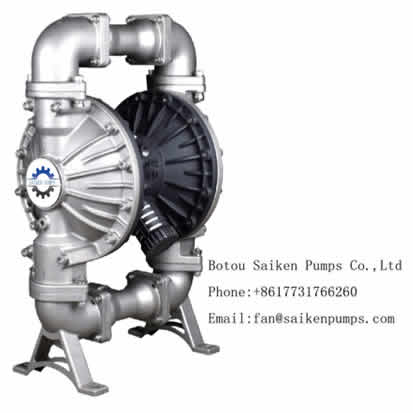Operating rules for pneumatic diaphragm pumps
1, pneumatic diaphragm pump before starting preparation:
(1) Check whether the lubricating oil level in the diaphragm pump working chamber is normal.
(2) Check the diaphragm pump plug connecting rod.
(3) Check whether the inlet and outlet filter of the diaphragm pump is smooth.
(4) Check whether the hydraulic fluid meets the working requirements.
(5) Check whether the diaphragm pump outlet pipeline and return pipeline are smooth, and use relevant instruments and regulating valves.
2, pneumatic diaphragm pump start
(1) Open the inlet valve of the diaphragm pump and confirm whether the inlet line is smooth.
(2) Open the diaphragm pump outlet valve.
(3) Adjust the pump stroke regulator to zero.
(4) Manual turning to confirm whether the rotation is flexible and there is no sense of resistance.
(5) Start the diaphragm pump, confirm whether the motor rotation direction is rotated according to the direction indicated by the motor upper arrow, and confirm that the diaphragm pump pump has no sound.
(6) Confirm the work after the pneumatic diaphragm pump starts:
① Confirm whether there are abnormal sounds in the parts of the diaphragm pump body.
② Check whether the diaphragm vibration is normal.
③ The temperature rise of the bearing of each part of the diaphragm pump body is too fast.
④ Slowly adjust stroke to 20% stroke.
⑤ Confirm whether there is oil leakage at each oil seal of the diaphragm pump body, and whether there is leakage or overheating at the plunger packing of the diaphragm pump.
Slowly adjust the stroke to 20%, 40%, 60%, 80%, 100%, observe whether the diaphragm pump outlet pressure and flow is normal, and confirm whether the motor current meets the requirements, and make a record. Note: Before starting again after stopping the pump, be sure to set the stroke to 0%.
3. Inspection points during normal operation of diaphragm pump:
(1) Check whether the diaphragm pump outlet pressure and outlet flow meet the requirements.
(2) Check whether the bearing temperature on the diaphragm pump body is higher than the normal temperature (bearing temperature can not be higher than 70 degrees or the ambient temperature of 35 degrees).
(3) Check whether the vibration is normal.
(4) Check whether the oil seal leaks oil.
(5) Check whether the filler leaks or overheats.
(6) Check whether the inlet and outlet check valve is normal.
(7) Confirm whether there are leakage points in each pipeline.
4, stop the pump:
(1) Confirm that the stroke regulator pointer is set to zero and stop the pump.
(2) After the pump is stopped, the diaphragm pump is isolated from the system. If maintenance is needed, the medium in the pump must be cleaned and discharged.
saiken Pumps is a manufacturer and supplier of pneumatic diaphragm pumps
